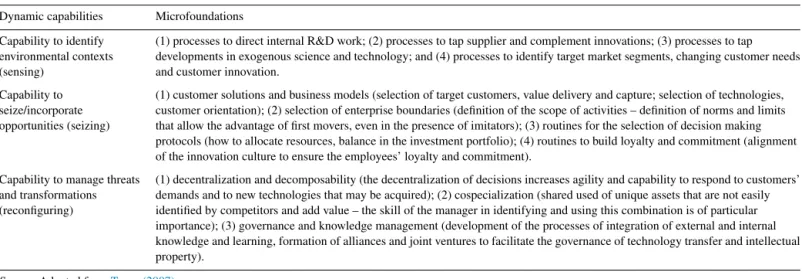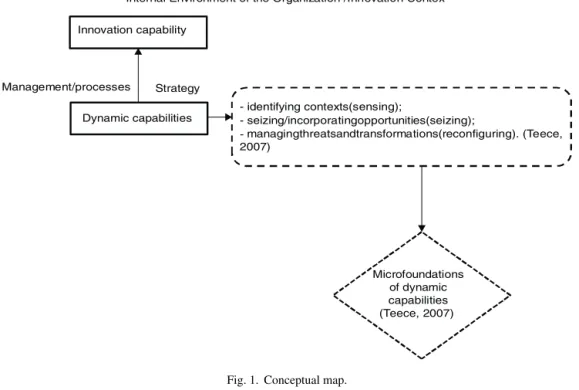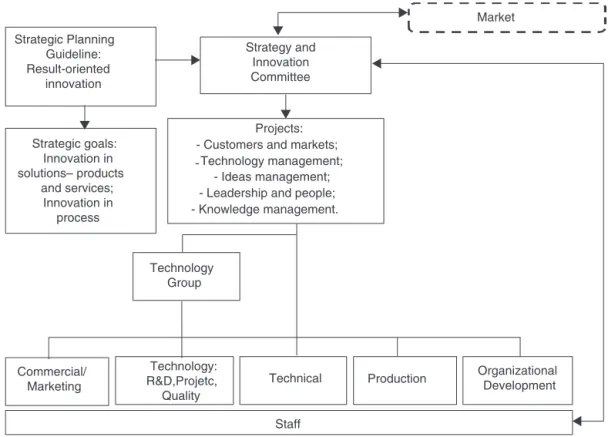Revista
de
Administração
http://rausp.usp.br/ RevistadeAdministração52(2017)479–491
Technology
Management
The
use
of
dynamic
capabilities
to
boost
innovation
in
a
Brazilian
Chemical
Company
A
utiliza¸cão
das
capacidades
dinâmicas
para
impulsionar
a
inova¸cão
em
uma
Empresa
Química
Brasileira
La
utilización
de
las
capacidades
dinámicas
para
impulsar
la
innovación
en
una
empresa
química
brasile˜na
Cristiane
Froehlich
a,∗,
Claudia
Cristina
Bitencourt
b,
Marilia
Bonzanini
Bossle
baUniversidadeFeevale,NovoHamburgo,RS,Brazil bUniversidadedoValedoRiodosSinos,SãoLeopoldo,RS,Brazil
Received30May2016;accepted23February2017 Availableonline8September2017 ScientificEditor:PaulaSaritaBigioSchnaider
Abstract
Dynamiccapabilitiesseektoexplainhowcompetitiveadvantagescanbebuiltinrapidlychangingenvironments.Thisstudyaimstoassesshowthe applicationofdynamiccapabilitiescancontributetotheexpansionofinnovationcapabilities.Datawascollectedontensemi-structuredinterviews withexecutivesfromachemicalcompany,andanalyzedusing qualitativecontentanalysis.Resultsindicatethat theapplicationofdynamic capabilitiescontributestothedevelopmentofinnovationcapabilitiesthroughtheconsolidationofthefirstdynamiccapability(sensing),which fostersinnovation.Sensingcanbeconsideredanorganizationalcapability,resultingfromtheintegrationbetweenorganizationalstrategiesandthe innovationpracticesoftheorganizationasawhole.Thisstudybringsthefollowingcontributionstheneedtoincludeanewmicrofoundationinthe sensingcapability,whichinthisstudyiscalled‘processestomanageinnovationonastrategiclevel’andtheneedtoadaptanothermicrofoundation relatedtothesensingcapability,called‘processesorientedtowardcollaborationwithsupplierstocomplementandstimulateinnovationswithin thecompany’.Itissuggestedthattheseprocessesshouldbereassessedintermsoftheirpotentialtogenerateandcomplementorganizational innovation.
©2017DepartamentodeAdministrac¸˜ao,FaculdadedeEconomia,Administrac¸˜aoeContabilidadedaUniversidadedeS˜aoPaulo–FEA/USP. PublishedbyElsevierEditoraLtda.ThisisanopenaccessarticleundertheCCBYlicense(http://creativecommons.org/licenses/by/4.0/). Keywords:Innovationcapability;Dynamiccapabilities;Microfoundations
Resumo
Ascapacidadesdinâmicasprocuramexplicarcomovantagenscompetitivaspodemserconstruídasemambientesquemudamrapidamente.Neste estudotem-secomoobjetivoanalisarcomoaaplicac¸ãodosmicrofundamentosdascapacidadesdinâmicaspodecontribuirparaaexpansãoda capacidadedeinovac¸ão.Osdados foramcoletadospormeiodedezentrevistassemiestruturadascomexecutivosdeumaempresaquímica,e analisadospormeiodaanálisedeconteúdoqualitativa.Osresultadosindicamqueaaplicac¸ãodosmicrofundamentosdascapacidadesdinâmicas contribuiparaodesenvolvimentodacapacidadedeinovac¸ão,atravésdaconsolidac¸ãodaprimeiracapacidadedinâmica(sensing),queestimulaa inovac¸ão.Sensingpodeserconsideradaumacapacidadeorganizacional,resultantedaintegrac¸ãoentreasestratégiasorganizacionaiseaspráticas deinovac¸ãodaorganizac¸ão.Alémdisso,esteestudotrazasseguintescontribuic¸ões:anecessidadedeincluirumnovomicrofundamentona
∗Correspondingauthorat:RS-239,2755,CEP93352000,NovoHamburgo,RS,Brazil. E-mail:cfroehlich@feevale.br(C.Froehlich).
PeerReviewundertheresponsibilityofDepartamentodeAdministrac¸ão,FaculdadedeEconomia,Administrac¸ãoeContabilidadedaUniversidadedeSãoPaulo –FEA/USP.
https://doi.org/10.1016/j.rausp.2017.08.007
capacidadedesensing,quenesteestudoéchamadode“processosparagerenciarainovac¸ãoemumnívelestratégico”eanecessidadedeadaptar outromicrofundamentorelacionadocomacapacidadesensing,chamadode“processosorientadosparaacolaborac¸ãocomosfornecedorespara complementareestimularinovac¸õesdentrodaempresa”.Sugere-sequeestesprocessosdevemserreavaliadosemtermosdeseupotencialdegerar ecomplementarainovac¸ãoorganizacional.
©2017DepartamentodeAdministrac¸˜ao,FaculdadedeEconomia,Administrac¸˜aoeContabilidadedaUniversidadedeS˜aoPaulo–FEA/USP. PublicadoporElsevierEditoraLtda.Este ´eumartigoOpenAccesssobumalicenc¸aCCBY(http://creativecommons.org/licenses/by/4.0/).
Resumen
Lascapacidadesdinámicastratandeexplicarcómoventajascompetitivaspuedenserconstruidasenentornosquecambianrápidamente.Eneste estudioseanalizacómolaaplicacióndelosmicrofundamentosdelascapacidadesdinámicaspuedecontribuiralaexpansióndelacapacidadde innovación.Sehanrecogidolosdatospormediodediezentrevistassemiestructuradasconejecutivosdeunaempresaquímica,yseleshaaplicado elanálisisdecontenidocualitativo.Losresultadosindicanquelaaplicacióndelosmicrofundamentosdelascapacidadesdinámicascontribuyeal desarrollodelacapacidaddeinnovaciónpormediodelaconsolidacióndelaprimeracapacidaddinámica(detección),quefomentalainnovación. Ladetecciónpuedeserconsideradacomounacapacidadorganizacionalqueresultadelaintegraciónentrelasestrategiasdeorganizaciónylas prácticasdeinnovacióndelaorganización.Seaportan,además,lassiguientescontribuciones:lanecesidaddeincluirunnuevomicrofundamentoen lacapacidaddedetección,queenesteestudiosellama“procesosparalagestióndelainnovaciónenunnivelestratégico”;ylanecesidaddeadaptar otromicrofundamentorelacionadoconlacapacidaddedetección,quesetraduceen“procesosdirigidosalacolaboraciónconlosproveedorespara complementaryestimularlainnovacióndentrodelaempresa”.Sesugierequeestosprocesosdebenserreevaluadosentérminosdesupotencial paragenerarycomplementarlainnovaciónorganizacional.
©2017DepartamentodeAdministrac¸˜ao,FaculdadedeEconomia,Administrac¸˜aoeContabilidadedaUniversidadedeS˜aoPaulo–FEA/USP. PublicadoporElsevierEditoraLtda.Esteesunart´ıculoOpenAccessbajolalicenciaCCBY(http://creativecommons.org/licenses/by/4.0/). Palavras-chave: Capacidadedeinovac¸ão;Capacidadesdinâmicas;Microfundamentos
Palabrasclave: Capacidaddeinnovación;Capacidadesdinámicas;Microfundamentos
Introduction
Dynamic capabilities seek to explain how competitive advantages canbeachievedinrapidlychangingenvironments. They include thecapacity to:(1) sense andshape opportuni-ties and threats; (2) seize opportunities; and (3) preserve an enterprise’scompetitivenessbymeansofimprovements, com-binations,protectionand,whenrequired,reconfigurationsofan enterprise’stangibleandintangibleassets(Day&Schoemaker, 2016;Teece&Leih,2016;Teece,Pisano,&Shuen,1997;Teece, Peteraf,&Leih,2016;Teece,2007).
Thisapproachmayexplainwhysomecompaniesmanageto identify andincorporate opportunitiesfromtheexternal envi-ronment into their routines andprocesses, by managing and assembling resources to obtain positive results while other companiesareunabletodevelopsuchcapabilities(Ambrosini, Bowman,&Collier,2009).
Since dynamic capabilities include those capabilities requiredtoaddressconsumerchangesandtechnological oppor-tunities (Teece, 2007), it can also support the understanding ofinnovationcapabilityapplication,whichisoneofthefocus ofthisstudy–understandingtherelationshipbetween innova-tion,dynamiccapabilitiesandinnovationcapability.Innovation capabilityfacilitatestheincorporationofknowledgeand learn-ingrelatedtonewproducts,servicesandprocesses.Innovation depends mostly on the way this process is conducted, i.e. it depends on the resources, routines and companies’ manage-mentcapability(Tidd, Bessant,&Pavitt, 2008).Thus,strong dynamic capabilities have an “orchestration dimension” that allowstheorganizationtoquicklyidealize,testandimplement newinnovations(Teece&Leih,2016).
Although research on dynamic capabilities is considered consistentinstudiesonstrategicmanagement,andareassociated withorganizationalchange,innovationandcompetitive advan-tage(Güttel,Konlechner,&Müller,2011),theareaisstillunder criticismsincetheconceptismostlytheoreticalanddifficultto implement(Arend&Bromiley,2009).Inordertoaddressthis issue,Teece(2007)introducedtheconceptofmicrofoundations – distinct skills, processes, procedures, organizational struc-tures,decisionrules,anddisciplinesthatwillcombinetoallow theimplementationofthedynamiccapabilitiesofsensing, seiz-ingandreconfiguring(Teece,2007)–thatrepresentanattempt tooperationalizeitthroughroutinesandprocesses.
innovation.In otherwords, theoperationalizationof dynamic capacities,throughmicrofoundations,contributestothe consoli-dationofinnovationcapabilityandthis,inturn,helpstoleverage innovationintheinvestigatedcompanyasdemonstratedinthis paper.
Thispaperthusaimstoanswerthefollowingresearch ques-tion:howcaninnovationbeboostedbydevelopingandapplying dynamiccapabilitiesaccordingtothemicrofoundationssensing, seizing and transforming? This study also aims to analyze how the application of microfoundations of dynamic capaci-tiescan contribute to the expansion of innovation capability. Thefocus onmicrofoundationsallowsthe researchersto ver-ifytheapplicabilityoftheconceptinadetailedway,sinceone of theweaknesses of theapproach of thedynamic capacities isthe lackof definitionof unitsof analysis.Kindström etal. (2012)emphasizethatdemonstratingmicrofoundationsare fun-damentalforbuildingdynamiccapacitiesandthatitsignificantly affectsthesuccessofinnovation.Thishappensthroughthe pro-cessvariationthatformsthebasisofthedevelopmentofdynamic capacities,accordingtoPasianetal.(2012).
Toanswertheproposedquestion,wehavechosentodevelop acasestudy inviewof theneedfor furtheringunderstanding microfoundationsinaspecificcontext.Havingthatinmind,a chemicalcompany–Artecola–wasselected,consideringthat thechemical sectorisadynamic area inwhichinnovationis essential.Thiscompanyisrecognizedasinnovativedueto:(a) itsrecognitionforinnovationindifferentfields;(b)innovation ispartofthemissionandorganizationalvaluesofthecompany; (c)itsdevelopmentofproductandprocesspatents;(d)the inclu-sionof innovationas partof thecompany’ssocialreports, as wellasthe30innovationawardsreceivedin2015.Innovation isanelementthatdifferentiatesArtecola fromotherchemical enterprises.
Thenextsectionpresentsthetheoreticalframeworkonthe contextualization of innovation and innovation capability, as wellastheconceptofdynamiccapabilitiesandtheirrespective microfoundations.Next,methodologicalproceduresarelisted. Section ‘Results’ provides an overview of Artecola and the analysisof the resultsof thisresearch.Finally, the final con-siderationsandthecontributionsofthisstudyarepresented.
Innovationandtheinnovationcapability
Innovation is the search for, discovery, experimentation, development,imitationandadoptionofnewproducts,new pro-ductionprocessesandneworganizationalconfigurations(Dosi, 1988).Innovation requires improvements and changes inthe operationofcomplextechnicalandorganizationssystems,ina processoftrial,errorandlearning(Tiddetal.,2008). Innova-tivecompaniesarethosethatfindthemeanstoexplorethelatent potentialofnewideasandcombinefactorsinamoreoptimized way(Francis&Bessant,2005).
Thedevelopmentofthecapabilitiesrequiredforinnovation isthe result ofcomplex interactionsbetween incentive struc-tures,humanresources, technologicaleffortsandinstitutional factors(Lall,1992).Companies andinnovationprocesses can be considered path dependent, which means that companies
that were innovativeinthe pasttend toinnovatemorein the present(Carrillo-Hermosilla,DelRío,&Könnölä,2010; Hor-bach,2008).Otherauthors(Pavitt,2005),however,refertothe conceptofpathcreationandminimizetheroleoftrajectoryin definingthenewdirectionsforacompany,highlighting contin-genciesassociatedwiththesectororthetechnologicalfield.In thatsense,accordingtoSchumpeter’scircularflow,economics tendstowardequilibrium,andthatequilibriumwillnot neces-sarilybethesamepointasbefore(Schumpeter,2008).
Inordertoachievesuccessfulinnovations,companiesneed tocombinedifferenttypesofknowledge,capabilities,skillsand resources,i.e.theyneedtodevelopthecapabilitytodetectand seizeopportunities,notonlytargetingnewmarketsbutalsoby finding newwaystothrive inestablished andmature markets (Fagerberg,2005;Knight,1967;Schumpeter,2008;Tiddetal., 2008).In acontextof changeandinnovation, dynamic capa-bilitiesbecomeanimportant concepttoorganizeresourcesin adistinctwayandincreasesagilitytoorganizationalprocesses by establishing routinesand proceduresthat translatea com-pany’strategies intospecificactions that areaccessibletoall organizationallevels.
Giventhatinnovationisaresultofcompany’specific char-acteristics, some authorssuch as Francisand Bessant (2005)
classify different innovation types according to the internal capabilitiesrequiredtoachievethem.Innovationcapabilityis, therefore, an ability to formulate and implement innovation strategies and it is associated with the capability to create, enlargeandmodifyresourcesemployedforinnovationinorder to develop new products, services, processes and/or markets (Dodgson,Gann,&Salter,2008).Innovationcapabilitycanalso beunderstood as atypeof organizationalstrategic capability. More specifically, it hastodo withthe alignment of innova-tionpracticeswithorganizationalstrategies,inordertogenerate valuetothecompany,toitsconsumersandtoother stakehol-ders.Itusuallytakesplaceinadeliberate,systematicwayand utilizesoneormoremodelstodevelopradicalorincremental innovation.
AccordingtoTiddetal.(2008),innovationisaprocessrather thananisolatedevent.Itmustthereforebemanagedinadynamic and systematic mannerand not focus on specific areasonly. Inthat sense,innovationcapabilityshouldnotberestrictedto R&D.Itshouldbepartofthecorporatecultureandencompass the entireorganizational environment(Tiddet al.,2008).For thistobeachieved,theseauthorspointoutthatinnovationmust be carriedout inastructuredmanner,followingroutinesthat characterizeeachstepintheprogressofinnovation(new prod-ucts,servicesorprocesses).Thus,wehighlighttheimportance of managinginnovationasadynamiccapability,whichisthe keydiscussionofthispaper.
Dynamiccapabilities
complementary resources and assets, in order to achieve sustainablecompetitiveadvantage.
This pioneering concept remains as a basic reference to studiesintheareaofresources,capabilities,competencesand strategy.Aliteraturereviewondynamiccapabilitiesshows simi-laritiesandcomplementaritiesinthedefinitionsusedbydifferent researchersthatadoptthisanalyticalapproach.Sincethe1990s, manytheoreticaleffortshavebeenmadetofurtherdevelopthe conceptinanattempttoimplementitinsectorssuchastourism (Camisón&Monfort-Mir,2012),services(Salunke, Weerawar-dena,&McColl-Kennedy,2011)andthefoodindustry(Beske, Land,&Seuring,2014).Thispaperexploresthedevelopment ofdynamiccapabilitiesinachemicalcompany.
Dynamiccapabilitiesarealternativelydefined asaprocess (Eisenhardt&Martin,2000;Eriksson,2014;Galunic& Eisen-hardt,2011;Shuen,Feiler,&Teece,2014),asaskill(Al-Aali &Teece, 2014;Andreeva & Chaika, 2006; Augier &Teece, 2008;Davies,Dodgson,&Gann,2016;Helfat&Peteraf,2015; Teeceetal.,1997;Teece,2007,2012,2016)andasthe capabil-ity(Winter,2003;Zahra&George,2002;Zahra,Sapienza,& Davidsson,2006)tointegrate,combine,build,reconfigureand changeorganizationalresources androutines tofosterchange andachievecompetitiveadvantages.Thus,thedynamic capa-bilitycanbeconceptualizedasaprocessorskillor capability tointegrate,combine,build,reconfigureandtransform organi-zational resources androutines to generatechanges andgain competitiveadvantage.
Also,withreferencetothediversityofconceptsofdynamic capabilities, it is possible to identify similarities related to: (a)rapidchangesintheenvironment;(b)processes,skills, capa-bilities,resources,routinesandassets;(c)capabilitytointegrate, combine, build, reconfigure, modify and change resources; (d)pathandpositiondependence;and(d)competitive advan-tage. The combination of these expressions, as presented by
Teeceetal.(1997),hasbecomethebasisfordynamiccapabilities approach.
Thisstudyisgroundedonthediscussionondynamic capabil-itiesproposedbyTeece(2007),whoseframeworkhasinfluenced
manyotherauthors(Day&Schoemaker,2016;Ellonenetal., 2009,2011;Katkaloetal.,2010;Kindströmetal.,2012;Pasian etal.,2012;Teece&Leih,2016;Teeceetal.,2016)whoaim of integrating strategy and innovation and provide ‘a model thathighlightsthemostcriticalcapabilitiesmanagementneeds to sustain the evolutionary and entrepreneurial fitness of the businessenterprise’(2007,p.1322).Teece’sframework(2007)
presentsthreedynamiccapabilities:(a)thecapacitytoidentify ecosystemcontexts(sensing);(b)thecapacitytoseizeand incor-porate opportunities(seizing);and(c)thecapacitytomanage threatsandtransformations(reconfiguring).
Thesedynamic capabilitiesaresupportedby microfounda-tions,anextremelyrelevantconceptinthiscontext,giventhat theyrefertoroutinesandprocessesthatwillallowthe imple-mentationofdynamiccapabilities.Teece(2007)emphasizesthe importance of distinguishingbetweentheseconcepts because differentprocesses inacompanycanrepresentimportant ele-mentsfordynamiccapabilities.Inotherwords,equalroutines andprocessesindifferentcompaniesmayormaynotbecome dynamiccapabilitiesfacilitators.Theseprocessesandroutines are the elements that cansustain innovation inacompetitive environment to increase a company’s competitive advantage overtime(Day&Schoemaker,2016;Pasianetal.,2012;Teece etal.,2016).Table1 presentsthedynamiccapabilitiesandits microfoundations.
Inlinewiththeconceptofdynamiccapabilitiesproposedby
Teece(2007),whichisrequiredtoalignorganizationalstrategies withinnovation,themainassumptionofthisstudy,whichwillbe investigatedinthecaseofArtecola,ispresented:dynamic capa-bilities,asproposedbyTeece(2007),canboostthedevelopment ofinnovationcapabilitythroughitsmicrofoundations.
Fig.1showstheconceptualmapofthestudy.
Fig.1showstheframeworkemployedinthisstudyto investi-gatetheapplicationofthethreedynamiccapabilitiesbymeans of their respectivemicrofoundations. Thesemicrofoundations are necessarybecause theycreatethe routines and processes thatsupportthedevelopmentandapplicationofdynamic capa-bilities. Oncedynamic capabilities are putinto practice, it is
Table1
Dynamiccapabilitiesandtheircorrespondingmicrofoundations. Dynamiccapabilities Microfoundations
Capabilitytoidentify environmentalcontexts (sensing)
(1)processestodirectinternalR&Dwork;(2)processestotapsupplierandcomplementinnovations;(3)processestotap developmentsinexogenousscienceandtechnology;and(4)processestoidentifytargetmarketsegments,changingcustomerneeds andcustomerinnovation.
Capabilityto seize/incorporate opportunities(seizing)
(1)customersolutionsandbusinessmodels(selectionoftargetcustomers,valuedeliveryandcapture;selectionoftechnologies, customerorientation);(2)selectionofenterpriseboundaries(definitionofthescopeofactivities–definitionofnormsandlimits thatallowtheadvantageoffirstmovers,eveninthepresenceofimitators);(3)routinesfortheselectionofdecisionmaking protocols(howtoallocateresources,balanceintheinvestmentportfolio);(4)routinestobuildloyaltyandcommitment(alignment oftheinnovationculturetoensuretheemployees’loyaltyandcommitment).
Capabilitytomanagethreats andtransformations (reconfiguring)
(1)decentralizationanddecomposability(thedecentralizationofdecisionsincreasesagilityandcapabilitytorespondtocustomers’ demandsandtonewtechnologiesthatmaybeacquired);(2)cospecialization(sharedusedofuniqueassetsthatarenoteasily identifiedbycompetitorsandaddvalue–theskillofthemanagerinidentifyingandusingthiscombinationisofparticular importance);(3)governanceandknowledgemanagement(developmentoftheprocessesofintegrationofexternalandinternal knowledgeandlearning,formationofalliancesandjointventurestofacilitatethegovernanceoftechnologytransferandintellectual property).
- identifying contexts(sensing);
- seizing/incorporatingopportunities(seizing);
- managingthreatsandtransformations(reconfiguring). (Teece, 2007)
Internal Environment of the Organization /Innovation Contex
Innovation capability
Dynamic capabilities Management/processes Strategy
Microfoundations of dynamic capabilities (Teece, 2007)
Fig.1.Conceptualmap.
Source:Bytheauthors.
possibletoboostacompany’sinnovationcapability.Moreover, webelievethatinnovationcapabilitycouldleverageinnovation. However,wepreferconsiderthisrelationshipindirectly since thereare many otherfactors that could influenceor leverage innovationsuchasabortivecapacity,learningbasedonpractice (internalcontext), knowledge transferand interorganizational learning(external andrelational context)among others. This lastlevelof analysiswillnotbe addressinthe presentpaper, whichfocuson understandingthedevelopmentof innovation capabilitybased on dynamic capabilities andtheir respective microfoundations.
Method
Aqualitativecasestudywascarriedoutforthisstudy,since thisapproachcontributestoenhanceanexistingtheory,being influencedbysocialcontext,allowingtheestablishmentofnew relationshipstobeinvestigatedandrevealingcomplexprocesses (Shah&Corley,2006).Therefore,thiscasestudyaimedto ana-lyzethecontributionofdynamiccapabilitiesandtheirrespective microfoundationstothedevelopmentoftheinnovation capabil-ity.Inthisregard,thechosencompanyshouldmeetthefollowing selectioncriteria:(a)berecognizedinthemarketforits innova-tioncapability;(b)haveinnovationasadeliberateorganizational strategy;(c)embodyaninnovation-orientedculture(innovation shouldbepartofcompany’smission,visionandorganizational values).
ThisledtotheselectionofArtecolaIndústriaQuímica.This companystandsoutbecause(a)itiswidelyrecognizedinthe differentsegmentsitoperates;(b)innovationispartofits mis-sionandvalues; (c)it produces productandprocess patents; (d)innovationispartofitssocialreporting.
A protocol was developed to guide data collection, as a recommendedstrategyforincreasingthereliabilityofthecase study(Yin,2005).Inviewoftheexploratory/descriptive char-acter of the study, the protocol was designed using the two categories identified in the theoretical framework:innovation capability and dynamic capabilities. The former focusses on understanding the innovation context while the latter triesto identifythethreedynamiccapabilitiesanditsrespective micro-foundations,asproposedbyTeece(2007).
Interviews anddocument analysis were carried out in the datacollectionstagetocomplementtheinformationcollected. Semi-structured,in-depthinterviewswereconductedwith man-agersofdifferent levelsandareas,indicatedbythecompany. Data on the differentareas representedby the managers was validatedusingtriangulation.Allinterviewswererecordedwith theconsentoftheparticipantsandthentranscribedforanalysis sothatanydoubtscouldbeclarifiedandpotential misinterpre-tationseliminated.Thiscontributestoensuringtheintegrityand reliabilityofdataanalysis.
Toprotectparticipants’identity,theywererandomlyassigned asequentialidentifier(Participant1–E1,Participant2–E2and soon).Table2summarizestheparticipants’profiles.
Thetotalnumberof interviews(10)fulfilled thesaturation criteria, i.e. therepetition of the data collectedindicatedthat further interviews were not required. An additional method-ologicalprecautionwasthetriangulationofdata,whichinthis studywasbasedontheparticipants’differentmanagerialareas andpositionsandonthedifferentdatacollectionformatsused (interviewsanddocumentaryanalysis).
Table2
Participants’profiles.
Job/position Lengthofservicein thecompany
Education
TechnologyManager 13months Chemistrytechnician.BScChemistry.MScOrganicChemistry.PhDMaterials Engineering.
TechnologyProjectsCoordinator 7years Chemistrytechnician.BScChemistry.MBABusinessandProjectManagement. OccupationalHealth,SafetyandEnvironment
Coordinator
3years Chemistrytechnician.BScEnvironmentalEngineering.BScOSH.International MBAEnvironmentalManagement.
ManagementandInnovationAnalyst 5years Chemistrytechnician.BScProductionEngineering(inprogress). PlanningandNewBusinessesManager 17years BScCommercialEngineering.
CoordinatoroftheFranciscoXavierKunst Foundation
3years BASocialScience.Specialist,HRPlanningandManagement.MAEducation. EnvironmentalAnalyst 2½years ChemicalEngineering.
InternalandInstitutionalMarketingCoordinator 1year Journalism.
DevelopmentConsultant 6years BABusiness.MBAStrategyandInnovation.
OrganizationalDevelopmentDirector 3years BScAccounting.MBABusinessManagement.MBASocialTechnology.
Source:Bytheauthors.
Table3
Categoriesofanalysis.
Category Subcategory
Innovationcapability (a)Contextualization. (b)Innovationtypes.
Dynamiccapabilities
(a)Capabilitiesandrespectivemicrofoundations: -capabilitytoidentifyenvironmentalcontexts(sensing); -capabilitytoseize/incorporateopportunities(seizing); -capabilitytomanagethreatsandtransformations (reconfiguring).
Source:Bytheauthors.
sources of evidence, particularly to supply details. The fol-lowingArtecoladocumentswereexamined:(a)thecompany’s socialreport;(b)book“60anos:soluc¸õesinovadorasqueunem” (60 years of innovative solutions that bind); (c) company’s website;(d)environmentalmanagementsystemhandbook;(e) articlesprintedinthecompany’smonthlynewsletter.
Alldatacollectedwereprocessedusingqualitative content analysis,amethodbywhichkeyelementsarebrokendowninto categoriesthatmatchthetheoreticalframeworkadopted. Cate-gorizationisidentifiedbySelltiz,Jahoda,andCook(1965)as an effective technique for data organization andreduction as theinformationisgroupedintoalimitednumberofcategories. Thefollowingcategories wereused inthisstudy:(1) innova-tioncapability–takingintoaccountorganizationalcontextsand innovationtypes;(2)dynamiccapabilities–thethreecapabilities (sensing,seizingandreconfiguring)andtheirrespective micro-foundationswereanalyzedtodeterminehowtheycontributeto boostingtheinnovationcapabilityatArtecolaIndústriaQuímica (Table3).
ThesecategorieswerecreatedfollowingBardin’s recommen-dations (2010),bywhichelements are first isolated andthen groupedtogetheraccordingtothefollowingcharacteristics:(a) mutuallyexclusive,i.e.eachelementbelongstoasingle cate-gory;(b)homogeneity:themutuallyexclusiveprincipledepends ofthehomogeneityofthecategories,soasinglecriterionshould beusedtodeterminehowthecategoryisorganized;(c) perti-nence: a category is considered pertinent when it is adapted
tothematerialofanalysisselectedandwhenitbelongstothe selectedtheoreticalframework,i.e.itissuitabletotheresearch aim;(d)objectivityandreliability,i.e.thecategoriesshouldbe clearlydefinedtoeliminateanydoubtsconcerningtheallocation of elements;(e)productivity:asetof categoriesisproductive isit provideselementsthatarerich ininferenceindexes,new assumptionsandconcretedata.
To ensure thevalidity of thestudy, inadditiontothe pro-cedures listed above (protocol, triangulation and saturation), contentanalysis wascarriedoutusing theNVivo10software to compare previously analyzed qualitative data. Therefore, dataanalysiswascarriedoutinthreephases:(a)pre-analysis; (b)explorationofthematerial;and(c)datatreatment,inference andinterpretation.
Results
Thischapteroffers anoverviewof theArtecolagroupand contextualizesthecompany’sinnovationcapabilityaccordingto theanalysisoftheinterviewsconductedinthestudy.Next,the innovationcapabilityisanalyzedintermsofdynamic capabili-tiesandtheirrespectivemicrofoundations.Finally,contributions fromthefirstdynamiccapability(sensing)arehighlightedasthe majortheoreticalandpracticalimplicationinthisresearch.
Companyoverviewanditsinnovationcapability
Artecolawasfoundedin1948anditis,stilltoday,aprivately heldfamilybusinessthatismanagedbyaShareholders’ Coun-cilandaBoardofDirectors.Thecompany’sheadquartersare locatedinthestateofRioGrandedoSul,inSouthernBrazil.The companyhas11unitsinBraziland8overseas(LatinAmerica andChina).ArtecolaIndústriaQuímicamanufacturesadhesives andlaminatesforthefootwear,furniture,textileandautomotive sectors.
companydefineditsmissionstatement asfollows:‘delivering innovative solutions tothe value chains whereit operates to generateoptimalreturnstoallstakeholders’.
Thisstrategicalignmentandtheformalizationof the inno-vation concept resulted in a number of benefits, including an increase ingross revenuesyear after year (Participant5), materializingthecompany’smajorinnovationgoalstodeliver completesolutionsbyaddingvalueandgeneratingresults (Par-ticipant2).Innovationalsofacilitatedotherstrategicprocesses, suchascompany’sinternationalinsertion(Participant5).
Includinginnovationinthestrategicplanwascrucialto pro-motean‘innovation culture’withinthecompany.Asaresult, thecompanygraduallyputintoplaceroutinesthat,overtime, generatedlearningoninnovation.Infact,innovationissaidtobe partofArtecola’sDNAanditfeaturesinthecompany’smission statementandvalues(Participant1).
Inordertofosteranddisseminateacultureofinnovation,an initiativecalled‘programofideas’,whoseaimwastoencourage theparticipationofallemployees,wascreatedandimplemented inthe 1990s. According toParticipant 2, ‘[the program]has aspecificoperation processandit isrunbytheplanning and newbusinessesarea,whichcoordinates[theprogram]to opti-mizeresultsandfosterinnovationamongstaff’.Participant1 underscoresthefactthat‘innovationispresentinallmessages, speechesandwelcomediscourses addressatthebeginningof eachsemester.[...]itreflectstheattitudeoftopmanagement,
andthetop-downcharacteristicoftheculturalprocessof inno-vationis.Innovationispervasivebecauseofthecharacteristics ofthecompany’.
Itisworthmentioningthatthecompany’sstrategic innova-tionguidelinepointsoutattwodifferenttypesof innovation: innovationinsolutions(productsandservices)andinnovation inprocesses.AccordingtoParticipant2,‘innovationinsolutions isinnovationthatgeneratesresultsandvaluetoconsumers,itis innovationinmarket-orientedproductsandservices,innovation that improves quality for consumers, increases their produc-tivity, reduces costs or makes their lives easier, [these] may be breakthrough or incremental innovations’. For Participant 1,‘productinnovationsare pursuedbymeans ofpartnerships and joint ventures’, which ‘boost learning and the develop-mentof newroutines’ (Participant 2). Innovation inservices iscomplementarytoinnovationinproductsandisidentifiedby themainareasof thecompany(commercial,marketing, tech-nical andorganizational development)for further assessment bytheStrategyandInnovationCommittee(Participants1and 2). Innovation inprocesses, which refers tointernal process, seeksto‘provideimprovementleapsinproductivity,efficiency, costreduction, simplifyprocesses andimprove internal qual-ity’(Participant5)andit isimplemented byworkteamsthat worktofostercontinuousimprovementsandprovidesolutions toone-offproblems.
Itwasobservedthatinnovationisnotlimitedtoasinglearea ofthecompany.Tiddetal.(2008)pointoutthattheinnovation capabilityshouldnot belimited toresearchanddevelopment (R&D)butitshouldbepartofthecorporatecultureand encom-passthewholeofthe organizationalenvironment.Toachieve this,theseauthorsemphasizethatinnovationhastobeconducted
inastructuredformat,accordingtoroutinesthat characterize eachstepinthedevelopmentofinnovation(newproducts, ser-vicesorprocesses).
Data indicates that Artecola has developed its innovation capability bydirecting its strategic alignmenttoward innova-tion processes, whichcorroborates the concept of innovation capability proposedby Dodgson etal.(2008).These authors state thatinnovation capabilitycanbeunderstood as a strate-gicorganizationalcapability.More specifically,itisrelatedto thealignmentofinnovationpracticeswithorganization’s strate-giestoaddvaluetothecompanyanditsconsumersandother stakeholders.
Accordingtotheinterviews,innovationatArtecolaisaresult oforganizationalprocessesthatarealignedwiththeirbusiness strategy, i.e. innovation is not restrictedto an organizational process. It is rather a strategy that is part of the company’s strategic plan, culture and routines. It is possible to claim that the companygenerates new products, services and pro-cessesthroughtheinnovationcapabilityaccumulatedalongits history.
ThissectioncontextualizedinnovationcapabilityatArtecola andhighlighted the factthat innovation is alignedwith com-pany’sstrategyandintegratedintothecompany’sstrategicplan. It was possibleto confirm that innovation is seenby partici-pants as a consolidated strategy that is part of the corporate culture.Itwasobservedthat innovationatArtecola isdivided intoinnovation insolutions(products andservices)and inno-vationinprocesses.Thenextsectionofferssomereflectionson innovation capability vis-à-vis dynamic capabilities andtheir respectivemicrofoundations.
Identificationofdynamiccapabilitiesandtheirrespective microfoundations
Thefirstdynamiccapabilityisthecapabilitytoidentify envi-ronmentalcontexts(sensing).Inthisregard,Artecolahasbeen observing and analyzing products, processes and services of multinationalchemicalcompaniessincethe 1970stoidentify andcreatenewneedsforitsconsumers.Aftersometime, the process to identify opportunities was formalized and, in the words ofParticipant4,‘thegreater thestakeholders’ involve-ment,themorelikelywearetoidentifyenvironmentalcontexts, duetocompany’sinteractionwiththem,allowingtofacilitateto identifynewneeds’.
Table4liststhemajormanagerialandoperationalprocesses identifiedatArtecolaforeachmicrofoundationassociatedwith thesensingcapability.
The four microfoundations listed by Teece (2007) can be identified in the managerial and organizational processes at ArtecolaandarelistedinTable4,withtherespective empha-sisoneachofthem,accordingtotheparticipants’perceptions. Whennewopportunitiesareidentified,theyneedtobe incorpo-rated.Toachievethis,Teece(2007)recallsthatitisnecessaryto developtheseizingcapability,whichdirectstheopportunities identified.
Table4
Majormanagerialandorganizationalprocessesthatundergirdthesensingcapability. Microfoundations(Teece,2007) ManagerialandorganizationalprocessesatArtecola
(1)Processesthatdirectinternal R&Dwork
Technologygroup–interdisciplinaryteamthatworkstotranslatestakeholders’needsinquarterlymeetingswhichanalyze thetechnologiescontrolledbythecompanyandlatentmarketneeds.Findingsfromthisgrouparewidelypublicizedinthe company’sR&DIntranet,acustomapplicationdevelopedbySAPtofacilitatecommunicationandoversightofprojectflow byemployees–Participants1and2;
ClarkandWheelwright’sfunnelmethodology(1993)ofinnovationforthedevelopmentofnewproducts; Projectmanagementmethodology(PMI).
(2)Processestotapsupplierand complementaryinnovations
Strategicguideline‘growthwithalliances’.Tofulfillthisguideline,thecompanypermanentlylooksforpartnerships(with suppliers,customersanduniversities)todevelopnewproducts(Participants5and6);Theimportanceofinternational alliancestofulfillthe‘result-orientedinnovationguideline’washighlightedbyParticipant4,whileParticipant1recalledthe definitionofstrategiesrelatedtointernationalalliances,whichcontributedtothedevelopmentoftechnologicalproduct innovations.
(3)Processestotapdevelopments inexogenousscienceand technology
Partnershipswithlocalandinternationaluniversityresearchcenters(Participant1);projectsinprogress,mainlythoseof basicresearch(Participant2);internationalrecognitionasaresultofpartnershipswithleadingplayers(Participant10); Participationofrepresentativesofthetechnology,commercial,technicalandmarketingareasinlocalandinternationalfairs whererelevantstate-of-the-artinnovationsandtechnologiesarepresented(Participant2).
(4)Processestoidentifytarget marketsegments,changing customerneedsandcustomer innovation.
Marketintelligencegroupthat‘carriesoutstudies,surveysontrend,monitorsthenewproductsofthecompetition,together withthetechnologyareatoidentifynewneedsthatcanyieldnewproducts,servicesandmarkets(Participant8);
Eventscreatedbythecompany:(i)ConsumerOffice(whereconsumerscanpresenttheirrequirementsandrepresentatives ofdifferentareasinthecompanycandiscusssolutions–Participant1),(ii)Inovarte(buildingproximitywithconsumersby meansofvisitsandpresentationofthewholerangeofproductsandservices–Participant1),(iii)Technologyforum (two-dayeventwithBrazilianandLatinAmericanteamstofostersynergiesbetweendifferentareasofthecompany, suppliersandcustomers,andidentificationofneedsandopportunities–Participant2),(iv)In3Blog(openchannelof communicationwiththemarket,underthecoordinationofthemarketingarea;(v)Localandinternationalfairs.
Source:Bytheauthors.
isassociatedwiththedevelopmentofnewproducts,processes, servicesandbusinessmodelsbymeansofthecreationof orga-nizational frameworksand the development of routines. It is possibletoclaimthatthiscapabilityisdevelopedoncethe pre-viouscapability(sensing)isconsolidated,i.e.oncethecompany hasclearmanagerialandorganizationalprocessesinplace.
Table 5 list the major managerial andorganizational pro-cessesidentifiedthatcorrespondtoeachmicrofoundationofthe seizingcapability.
Datacollectedshowedthatthecompanyneededtoimprove itsorganizationstructure alongthepathtoseizeand incorpo-rateopportunitiesthatwereidentifiedinordertoaddressmarket needsandfosterthe creationof innovationsinproducts, pro-cessesandservices.Thiswasachievedbythecreationofnew areastomanage processes, suchas newbusinesses planning, R&D,thestrategyandinnovationcommitteeandthetechnology group,allofwhichweredescribedabove,inthesectiononthe sensingcapability.Inaddition,‘internalprogramswere devel-opedtofosteracultureofinnovationandengageemployeesin the disseminationof innovation onalllevels of the organiza-tion’,asParticipant4explained.Itcanthusbeclaimedthatthe creationofprocessestoassisttheidentificationof environmen-tal contexts(sensingcapability) requiredthe creation of new areasandimprovementsinexistingareastodeveloptheseizing capability.
ForTeece(2007),onceanenterprisehasdefinedmanagerial andorganizationalaspectstoidentify(sensing)andincorporate (seizing)opportunities,itisnecessarytodevelopthecapability tomanagethreatsandmodifications(reconfiguring).
Thisthird,andlast,capabilityreferstotheactivitiesrequired tomaintainadjustmentsoverthelifeofanenterprise,asitsassets andstructuresarerealigned(Teece,2007).
Table 6 lists the main managerial and organizational pro-cesses that were identified for each microfoundation of the reconfiguringcapability.
In spiteofthe alliancesmentioned,Participant7 reiterated that, as far as the managementof internalknowledge is con-cerned,‘someinformationisstilldepartmentalized,we could improvecooperationintermsofinformationsharing;thiswould improveinnovationmanagement’.Toachievethis,actionssuch astheimplementationofArtecolaIntegratedManagement Sys-tem (SIGA) were conceived with the aim of ‘reconfiguring informationflowsandinformationsharinginavirtual environ-ment’(Participant8).However,thissystemisstillinthefinal adjustmentsphase.
Forthemanagement ofthreatsandtransformations,itwas observedthatmanagementplaysakeyroleonthereconfiguring capability.Inadditiontoidentifying(sensing)andincorporating (seizing) opportunities,companiesneed tolearnhow to man-agethesecapabilitiestoprotecttheirinternalassets.Toachieve this, committees, groups and teams were set up at Artecola to manage and make decisions related to their department. The companydevelopedthecapabilitytomanage technologi-cal assetsbyestablishing allianceswithanumberof partners andimplementedanintegratedmanagementsystemtomanage informationandknowledge.
Table5
Majormanagerialandorganizationalprocessesthatundergirdtheseizingcapability.
Teece’smicrofoundations (2007)
ManagerialandorganizationalprocessesatArtecola
(1)Customersolutionsand businessmodel
-Thecompany’sbusinessmodelincludesasetofinterrelatedactivitiestoaddvaluetoconsumers(Participant3)whichwasbased onthestrategicguidelinesofthestrategicplan(Participant10).
(2)Selectionofenterprise boundaries
-Establishingallianceswithconsumers,suppliers,researchcentersanduniversities. (3)Routinesfortheselection
ofdecision-making protocols
-Routinesaredevelopedbymeansofregularmeetings(Participant1)toassesstheviabilityofnewproductsandservices;(b) formalmeetingsconductedbythestrategyandinnovationcommittee;(c)meetingsconductedbythetechnologyareatoassessthe stagesoftheinnovationfunnelmodel.
(4)Routinestobuildloyalty andcommitment
-Regularactionsandactivities,suchas:(a)‘Welcome’event(heldinJanuarywithallemployeestodirectandinformstrategic intentions,theresultsofthepreviousyearandnewaimsforthecurrentyear);(b)internalcampaignstoreinforceDNApoints (innovation,internationalinsertionandsustainability),underthecoordinationoftheorganizationaldevelopmentarea,which publishesnewsletters,handbooks,magazinesandleafletstoprovideup-to-dateinformation);(c)managementandhumanresources traininginitiativestobuildstaffloyaltyandcommitment;(d)organizationofteamswithstafffromdifferentareastobuild commitment.Thisisassociatedwithfosteringinnovationinprocesses;and(e)programofideas(since2004,acommunication channelthatengagesstaff,stimulatescreativityandparticipationinthebusinessandcontributestopromoteacultureofinnovation (Participant5).
Source:Bytheauthors.
Table6
Majormanagerialandorganizationalprocessesthatundergirdthereconfiguringcapability. Microfoundations Managerialandorganizationalprocesses
(1)Decentralizationand decomposability
-Formationofstrategiccommitteesthatmakedecisionsrelevanttotheirfieldofwork,withafocusonthetransitionfromafamily managedtoaprofessionallymanagedbusiness.Creationofshareholders’councilsandaboardofdirectors,whichledtothe creationofdecision-makingcommittees.
(2)Cospecialization -Capabilitytomanagetechnologicalassetsandalliancestomobilizeresourcesandinnovationcapabilities(Participant4). (3)Governanceand
knowledgemanagement
-Governancetocontemplatethedevelopmentofinternalandexternalknowledgeintegrationprocessesandlearning. -ArtecolaIntegratedManagementSystem(SIGA);
-Allianceswithconsumers,suppliers,multinationalcompaniesandpartnershipswithresearchcentersanduniversitytogainaccess toexpertiseandlearninginordertoimproveandfacilitatetheinnovationcapabilityoftheorganization,asdiscussedabove,and jointventures.
Source:Bytheauthors.
andtheir respective microfoundations, as proposed by Teece (2007).Itcanbeobservedthatthesecapabilitiescontributedto thedevelopmentoftheinnovationcapabilityatArtecolathrough thecreationofmanagerialandorganizationalprocesses.
It should be highlighted that complementarities between thesecapabilities were identified. Mostof the actions identi-fiedinthefirstcapability(sensing)areseenagainintheother two.Itispossibletosaythatagivenactionoractivityidentified inthefirstcapabilitybecomesthefoundationforthe develop-mentofthesecondcapabilityandsoon.Thisredundancyisan importantelementintheanalysisasitreflectseffortstoidentify relevantpointsandconvergingactions.Thenextsectionpresents anddiscussesthemajorcontributionsofdynamiccapabilitiesto boosting innovation inthe casestudied, with a focus on the microfoundationsofthefirstcapability.
Contributionofthesensingcapabilityforboosting innovation–implicationsfortheoryandpractice
Innovationgoesfarbeyonddevelopingproducts–itincludes thecapabilitytorenewabusinessandtheexpansionandcreation ofnewmarkets(Teece,2007).Therefore,theabilitytosenseand
shapeopportunitiesandthreats,representedbythefirstdynamic capability,mustbefullydeveloped.
Dataindicatedthatthefirstdynamiccapability(sensing)is consolidatedatArtecola,asanumberof routinesareinplace to support the creation and interpretation of new opportuni-tiesthroughtheestablishmentoforganizationalandmanagerial processestoincorporatethesemicrofoundations(Day& Schoe-maker,2016;Ellonenetal.,2009;Ellonenetal.,2011;Katkalo etal.,2010;Kindströmetal.,2012;Pasianetal.,2012;Teece& Leih,2016).
Sensinginvolvesproactivelycreatinghypothesesabout the futureimplicationsofnewproducts,servicesandbusiness mod-elsandtheprocessofscenarioplanningcanassistorganizations inpreparingforchangeacrossmultipledimensions(Teeceetal., 2016).Thissectionhighlightsmajortheoreticaldevelopments andproposesarevisedversionofthesecondmicrofoundation aswellasanewmicrofoundationforthesensingcapabilityin ordertoexpandtheinnovationcapabilityofthecompany.
anincreasinglyglobalizedworld,withlarge-scalecompetitors that haveadvanced R&D capabilities anda global presence? The prevalent strategy in this case has been the creation of internationalalliances,whichisillustratedbypartnershipswith Germany(Rhenoflex,Jowat),Italy(G.O.R.), France (Protech-nic,AECPolymers),Switzerland (Forbo),USA(SprayLock) and China (Orisol). The establishment of strategic alliances is anagreement between two or morecompanies for the co-developmentofanewtechnologyorproduct(Tiddetal.,2008). Itisconsideredaneffectivemechanismforaccesstoexternal sourcesofknowledge(Capaldo,2007;Gulati,1998).
In the case of Artecola, the search for partnerships isnot limitedtocomplementinginnovations,as suggestedbyTeece (2007)butitisalsousedtointroducenewproductsinthe mar-ket.Chesbrough(2006)stressesthatexternalknowledgecanbe integratedthroughouttheinnovationprocessthroughincipient ideastodeepenappliedresearch,throughconceptsreadytobe developedinproducts,throughproductsreadytothemarketor throughdistributionchannels.Theintentionaluseofinflowsand outflowsofknowledgeaimstoaccelerateinnovationandexpand markets(Chesbrough,2006).
The company is not limited to partnerships with suppli-ers.Collaborationswithsuppliers,competitors,customers,end users, institutions,partnersfromotherindustriesfacilitatethe ability to perceive and interpret the future and to innovate (Kyläheiko&Sandström,2007).Thus,thisstudysuggeststhat
Teece’ssecondmicrofoundation(2007)shouldberewrittenas follows:‘processestoidentifyandestablishpartnershipsto man-ageorcomplementorganization’sinnovations’.
In additiontothefourmicrofoundationsthatundergirdthe sensingcapability,assuggestedbyTeece(2007),anew micro-foundation was identified from the empirical data collected, whichinthisstudyisdefinedas‘processestodirectinnovation onastrategiclevel’.Quadros(2005)highlightstheimportanceof theinstitutionalizationofprocessesandroutinesforastructured practice ofinnovationfromastrategicperspective.Tiddetal. (2008) emphasizethat innovationis notanisolated eventbut ratheraprocessthatmustbemanagedinadynamicand inte-gratedway.Inotherwords,itisnotenoughtomanageordevelop skillsinsomeisolatedareasofthecompany,suchasR&D,but acultureforinnovationshouldbedeveloped(Dobni,2008).
Pisano (2015)stressesthat withoutaninnovation strategy, innovationeffortscanbecomeasetofcentralizedpracticesin R&D.Still,hesaysthatcompaniesrarelyarticulatestrategies to align their innovation efforts with their business strate-gies, generating performance problems. The problem is that an organization’s innovation capability results froma system of innovation,that is,itreferstoacoherent setof interdepen-dentprocesses andstructuresthat indicateshowthecompany addressesnewproblemsandsolutions.Forthisitisnecessary theinstitutionalizationofinnovationprocessesfromthe strate-gic levelof theorganizationtopromotethe alignmentamong thedifferentareasandteams.
Thisnewmicrofoundationisjustifiedbytheestablishment, in2007,ofa‘strategyandinnovationcommittee’atArtecola, whoseaimistoplanandmanageinnovationstrategies. Commit-teemembershipincludesshareholders,counselorsandmanagers specialized onthe topiconinnovation.The committee’srole,
Strategic Planning Guideline: Result-oriented
innovation
Strategic goals: Innovation in solutions– products
and services; Innovation in process
Strategy and Innovation Committee
Projects: - Customers and markets;
-Technology management;
- Ideas management; - Leadership and people; - Knowledge management.
ComerciaCommercial/Marketing Comercia Comercia Comercia Comercia
Technology: R&D,Projetc, Quality
Technical Production Organizational
Development
ComerciaTechnology
Group
Market
Staff
Fig.2.Rolesofthestrategyandinnovationcommittee.
Table7
Microfoundationsofthesensingcapability.
Capabilitytoidentifyenvironmentalcontexts(sensing) (1)Processestodirectinnovationonastrategiclevel(new); (2)ProcessestodirectinternalR&Dtasks;
(3)Processestotapsupplierandnotonlycomplementbutgenerateinnovation (new);
(4)Processestotapdevelopmentsinexogenousscienceandtechnology; (5)Processestoidentifytargetmarketsegments,changingcustomerneedsand customerinnovation.
Source:Bytheauthors.
whichisshowninFig.2,is‘toorganizeandmakeinnovation sys-tematicinordertounderstandandanticipatemarketchangesand exceedcustomerexpectations’(Participant9)and‘toalign dif-ferentinnovationinitiativeswithourorganizationalstrategies’ (Participant2).
Fig.2showsthatinordertomeettheguidelineandthe strate-gicaims of innovation, the Committee works toidentify and interpretmarketsigns,aswellascapture,inasystematic man-ner,the ideasproposedby employees.Allselected signsand ideasare classified into five dimensionsfor the development ofprojects: consumersandmarkets,technologymanagement, ideas,leadership,andpeopleandknowledgemanagement.After classification,theserequests aretransferredtothe technology group,whichallocatestasks,accordingtotherequired compe-tencies,toimplementtheproject.
Itwasthenpossibletoanalyze,fromthedatacollected,that the company’s innovation capability originates in the align-mentof strategic guidelines withthe innovation andstrategy committee,whichidentifies,together withdifferent company areas, market opportunities and captures and assesses ideas frominternalandexternalsources.Theinceptionofthe strat-egyandinnovationcommitteeunderscoresthekeyroleplayed byinnovationonthebusinessoftheorganizationandfacilitates the identification of environmental contextsto learn,interact and assess information on external ecosystems expectations. The committee is also responsible todisseminate innovation throughoutthecompany(Participant1).
Forthisreason,itwasimportanttoaddanew microfounda-tiontothesensingcapability,whichinthisstudywasdefined as‘processestomanageinnovation onastrategic level’.This microfoundationwasnot identified byTeece(2007),butwas basedontheempirical datacollected,whichshowed theseto beanessentialelementintheconceptionanddisseminationof innovationstrategies.Thismicrofoundationspurstheprocessof translatingstrategiesintoinnovativeactions.
ThisanalysisofsensingatArtecolademonstratesits empha-sison the implementationof the guidelines proposed by the innovationandstrategycommittee,whichworkstoensurethat operationalaspectsareaddressedswiftly.Asaresult,the com-panyfaces nohurdles when implementing strategies. On the contrary,itisquiteagileinthisaspect.
AnanalysisofthedataonthesensingcapabilityatArtecola suggeststhatthiscapabilityissupportedbythefollowing micro-foundations(Table7).
Conclusions
Intheliteraturereviewondynamiccapabilities,sensing, seiz-ing and reconfiguring capabilities proposed by Teece (2007)
wereidentifiedaspotentialcontributorstothedevelopmentof innovationcapabilities.Thisstudyshowedthatthistheoretical frameworkisakeyelementinthe developmentofinnovation capabilities, and it is recommended for the study of organi-zational strategies, being associated with transformation and innovation contexts. It is also characterized by the ongoing mobilizationof resourcestoaddresschangingbusiness strate-giesinadynamicenvironment.Becauseofthesecharacteristics, dynamiccapabilitiesapproachoffersadifferentperspectiveon innovationcapabilitiesandhighlightstheirpotentialtogenerate opportunitiesforbusinessrenewal.
InthespecificcaseofArtecola,itcanbesaidthatdynamic capabilities and their respective microfoundations have con-tributed to developing innovation capabilities by means of routinesandmanagerialandorganizationalprocesses.The com-panyestablishedasystemtoinnovateandpursueitsstrategic guideline.
Therefore,itispossibletohighlightthat(1) themajor ele-mentsthatimproveandcontributetoexpandinginnovationin thiscasearethestrategicalignmentandtheformalinnovation strategyofthecompany,whichledtothedevelopmentofa cul-tureofinnovation.Anotherrelevantpointis(2)theconsolidation ofthefirstdynamiccapability(sensing)toboostinnovation.This ensuressensingbecomesacapabilityofthecompany,the orga-nizationalstrategiesandtheinnovativepracticesofthewhole companyaresystematicallyarrangedinaprocessthatpermeates allareasandstaff.
Inthissense,themajortheoreticalcontributionofthisstudyis (3)theadditionofanewmicrofoundationtothesensing capabil-ity,namely‘processestomanageinnovationonastrategiclevel as amicrofoundationofthesensingcapability’,i.e. processes that precede the processes to directinternal R&D tasks sug-gestedbyTeece(2007).Theanalysisofempiricaldatashowed thatinnovationatArtecolaisnotrestrictedtoR&D.Thecreation of the strategyand innovationcommittee andof the technol-ogy group,whichcomprehendmanagerial andorganizational processes that foster the capability to identify environmental contexts,isquiterelevantinthiscontext.Actionsinprogressat Artecolapointoutattheneedforprocessestodirectinnovations onastrategiclevel.
The need (4) to adjustthe second microfoundationof the sensing capabilitywas identified, andit wasdefined as ‘pro-cesses to identify and establish partnerships to manage or complementanorganization’sinnovations’.Itissuggestedthat thisprocessshouldberethought totakeinto accountits rele-vancetogenerate(andnotonlycomplement)innovationatthe organization.
planningguideline,thecompanyisalwayssearchingfor part-nershipsthatcanleadtothedevelopmentofnewproducts.These maytaketheformofpartnershipswithsuppliers,customers, uni-versities,researchcentersorBrazilianandinternationalfirmsto generateorcomplementinnovations.
It was observed that most of the actions identified in the sensing capability feature again in the other two dynamic capabilities. It is possible to say that (6) a given action or activity identified inthe first capability operatesas the foun-dation for the development of the second capability and so on.(7)Redundancy is,therefore,animportantelementinthis analysis as it reflects the effort to highlight what is relevant and the convergence of actions, all of which amount to a process-orientedcomplementaryviewofdynamiccapabilities. It was also observed that dynamic capabilities consist of skills, processes androutines that enable the organization to manageandmobilizeitsresourcesandassetstoaddressmarket needsandchanges.Therefore,the dynamiccapabilitiesfound intheinternalenvironmentpromoteorganizationaldevelopment andsupportinnovationcapabilities.
Asafinalcontribution, (8)theimplementationofdynamic capabilitiesbymeansof organizationalpracticesandroutines that are grouped according totheir microfoundations should behighlighted.Thiseffortaimedtoaddressthegapfoundin dynamiccapabilities’literature,whichisconsideredextremely theoreticalandhardtounderstandgivenitsapplication.
Alimitationofthisstudyreferstothefactthatthesefindings cannotbeextendedtoothersituations,asthisisauniquecase studybasedontheperceptionsofthecompany’sexecutives.In addition,the focusof the study wasthe internalenvironment anddidnotextendtootherstakeholders,suchasconsumersand suppliers,whocouldhavecontributedtowidenthescopeandthe resultofthestudy.Atlast,wedidnotdirectlyaddresstherelation betweeninnovationcapabilityandinnovation.Ourfocuswason theoperationalizationofinnovationcapabilitybasedondynamic capabilitiesandtheirsmicrofoundations.
Wesuggested that furtherresearchon thistopiccould (1) address the contribution of dynamic capabilities to leverage innovation (focus on strategic level) and also, understanding innovation capability taking on board the perceptions of dif-ferentstakeholders(focusonoperationallevelbutconsidering organizational external perceptions).Thiswould improve the theoreticalframeworkandpavethewaytoquantitativestudies thatcouldvalidatetheconstructsadopted.
Conflictsofinterest
Theauthorsdeclarenoconflictsofinterest.
References
Al-Aali,A.,& Teece,D.J.(2014). Internationalentrepreneurship and the theoryofthe(Long-Live)internacional firm:Acapabilities perspective. EntrepreneurshipTheoryandPractice,38(January(1)),95–116.
Ambrosini,V.,Bowman,C.,&Collier,N.(2009).Dynamiccapabilities:An explorationofhowfirmsrenewtheirresourcebase.BritishJournalof Man-agement,20(1),9–24.
Andreeva,T.,&Chaika,V.(2006).Dynamiccapabilities:Whattheyneedtobe dynamic?SãoPetersburgo:St.PetersburgStateUniversity.
Arend,R.J.,&Bromiley,P.(2009).Assessingthedynamiccapabilitiesview: Sparechange,everyone?StrategicOrganization,7(1),75–90.
Augier,M.,&Teece,D.J.(2008).Strategyasevolutionwithdesign:The foun-dationsofdynamiccapabilitiesandtheroleofmanagersintheeconomic system.OrganizationStudies,29(8–9),1187–1208.
Bardin,L.(2010).Análisedeconteúdo.Lisboa:Edic¸ões70.
Beske,P.,Land,A.,&Seuring,S.(2014).Sustainablesupplychainmanagement practicesanddynamiccapabilitiesinthefoodindustry:Acritical analy-sisoftheliterature.InternationalJournalofProductionEconomics,152, 131–143.
Camisón,C.,&Monfort-Mir,V.M.(2012).Measuringinnovationintourism fromtheSchumpeterianandthedynamic-capabilitiesperspectives.Tourism Management,33(4),776–789.
Capaldo,A.(2007).Networkstructureandinnovation:Theleveragingofadual networkasadistinctiverelationalcapability.StrategicManagementJournal, 28(6),585–608.
Carrillo-Hermosilla,J.,DelRío,P.,&Könnölä,T.(2010).Diversityof eco-innovations:Reflections fromselectedcasestudies. Journalof Cleaner Production,18(10),1073–1083.
Chesbrough,H.W.(2006).Openinnovation:Anewparadigmfor understand-ing industrialinnovation.InH.W.Chesbrough,& W.J.Vanhaverbeke (Eds.),Openinnovation:Researchinganewparadigm.NewYork:Oxford UniversityPress.
Clark,K.B.,&Wheelwright,S.C.(1993).Managingnewproductandprocess development:Textandcases.NewYork:FreePress.
Day,G.S.,&Schoemaker,P.(2016).Adaptingtofast:Changingmarketsand technologies.CaliforniaManagementReview,58(Summer(4)),59–77.
Davies,A.,Dodgson,M.,&Gann,D.(2016).Dynamiccapabilitiesincomplex projects:ThecaseofLondonHeathrowTerminal5.ProjectManagement Journal,47(April–May(2)),26–46.
Dobni,C.B.(2008).Measuringinnovationcultureinorganizations:The devel-opment ofa generalized innovationcultureconstruct usingexploratory factor analysis. European Journal of Innovation Management, 11(4), 539–559.
Dodgson,M.,Gann,D.,&Salter,A.(2008).Themanagementoftechnological innovation:Strategyandpractice(2nded.).NewYork:Oxford.
Dosi,G.(1988).Thenatureoftheinnovativeprocess.InTechnicalchangeand economictheory.pp.221–238.LondonandNewYork:PinterPublisher.
Eisenhardt,K.M.,&Martin,J.A.(2000).Dynamiccapabilities:Whatarethey? StrategicManagementJournal,21,1105–1121.
Ellonen,H.,Jantunen,A.,&Kuivalainen,O.(2011).Theroleofdynamic capa-bilitiesindevelopinginnovation-relatedcapabilities.InternationalJournal ofInnovationManagement,15(3),459–478.
Ellonen, H.-K., Wikström, P., & Jantunen, A. (2009). Linking dynamic-capability portfolios and innovation outcomes. Technovation, 29(11), 753–762.
Eriksson,T.(2014).Processes,antecedentsandoutcomesofdynamic capabili-ties.ScandinavianJournalofManagement,30(March(1)),65–82.
Fagerberg,J.(2005).Innovation:Aguidetotheliterature.InJ.Fagerberg,D. Mowery,&R.Nelson(Eds.),TheOxfordhandbookofinnovation(pp.1–27). Oxford:OxfordUniversityPress.
Francis,D.,&Bessant,J.(2005).Targetinginnovationandimplicationsfor capabilitydevelopment.Technovation,25(3),171–183.
Galunic, D. C., & Eisenhardt, K. M. (2011). Architectural innovation and modularcorporateforms.Academyof ManagementJournal,44(2), 1229–1249.
Gulati,R.(1998).Alliancesandnetworks.StrategicManagementJournal,19, 293–317.
Güttel, W., Konlechner, S.,& Müller, B. (2011).The boundaries of rule-breaking:Dynamiccapabilitiesandorganizationaldefense.In27EGOS colloquium,July7–9.
Helfat,C.E.,&Peteraf,M.A.(2015).Managerialcognitivecapabilitiesandthe microfoundationsofdynamiccapabilities.StrategicManagementJournal, 36(June(6)),831–850.
Katkalo,V.S.,Pitelis,C.N.,&Teece,D.J.(2010).Introduction:Onthenature andscopeofdynamiccapabilities.IndustrialandCorporateChange,19(4), 1175–1186.
Kindström,D.,Kowalkowski,C.,&Sandberg,E.(2012).Enablingservice inno-vation:Adynamiccapabilities approach.Journalof BusinessResearch, 66(8).
Knight,K.E.(1967).Adescriptivemodelofintra-firminnovationprocess. JournalofBusiness,40,478–496.
Kyläheiko,K.,&Sandström,J.(2007).Strategicoptions-basedframeworkfor managementofdynamiccapabilitiesinmanufacturingfirms.Journalof ManufacturingTechnologyManagement,18(8),966–984.
Lall,S.(1992).Technologicalcapabilitiesandindustrialization.World Devel-opment,20(2),165–186.
Pasian,B.,Sankaran,S.,&Boydell,S.(2012).Projectmanagementmaturity: Acriticalanalysisofexistingandemergentfactors.InternationalJournal ofManagingProjectsinBusiness,5(1),146–157.
Pavitt,K.(2005).InnovationProcesse.InJ.Fagerberg,D.Mowery,&R.Nelson (Eds.),TheOxfordhandbookofinnovation(pp.86–114).Oxford:Oxford UniversityPress.
Pisano,G.(2015).Youneedaninnovationstrategy.HarvardBusinessReview (JuneIssue).
Quadros,R.(2005).PadrõesdeGestãodainova¸cãotecnológicaemempresas brasileiras:Asdiferen¸casportamanho,nacionalidadeesetordenegócios. RelatóriodePesquisa.Campinas:UNICAMP.
Salunke,S.,Weerawardena,J.,&McColl-Kennedy,J.R.(2011).Towardsa modelofdynamic capabilitiesininnovation-basedcompetitivestrategy: Insightsfromproject-orientedservicefirms.IndustrialMarketing Manage-ment,40(8),1251–1263.
Schumpeter,J.(2008).Thetheoryofeconomicdevelopment(14thed.).New Jersey:Transaction(orig.2011).
Selltiz,C.,Jahoda,M.,&Cook,S.W.(1965).Métodosdepesquisanasrela¸cões sociais.SãoPaulo:EPU.
Shah, S. K.,& Corley, K. G.(2006). Building better theoryby bridging thequantitative–qualitativedivide.JournalofManagementStudies,43(8), 80–92.
Shuen,A.,Feiler,P.,&Teece,D.J.(2014).Dynamiccapabilitiesintheupstream oilandgassector:Managingnextgenerationcompetition.EnergyStrategy Reviews,3(September),5–13.
Teece,D.J.,&Leih,S.(2016).Uncertainty,innovation,anddynamic capa-bilities: An introduction. California Management Review, 58(Summer (4)),5–12.
Teece,D.J.,Peteraf,M.,&Leih,S.(2016).Dynamiccapabilitiesand organi-zationalagility.CaliforniaManagementReview,58(Summer(4)),13–35.
Teece,D.J.(2016).Dynamiccapabilitiesandentrepreneurialmanagementin largeorganizations:Towardatheoryofthe(entrepreneurial)firm.European EconomicReview,86(C),202–216.
Teece,D. J.(2012).Dynamic capabilities:Routinesversus entrepreneurial action.JournalofManagementStudies,49(December(8)).
Teece,D.J.(2007).Explicatingdynamiccapabilities:Thenatureand micro-foundationsof(sustainable)enterpriseperformance.StrategicManagement Journal,28(13),1319–1350.
Teece, D., Pisano, G., & Shuen, A. (1997). Dynamic capabilities and strategic management. Strategic Management Journal, 18(7), 509–533.
Tidd,J.,Bessant,J.,&Pavitt,K.(2008).GestãodaInova¸cão(3rded.).Porto Alegre:Bookman.
Winter,S.G.(2003).Understandingdynamiccapabilities.Strategic Manage-mentJournal,24(10),991–995.
Yin,R.K.(2005).EstudodeCaso:Planejamentoemétodos(2nded.).Porto Alegre:Bookman.
Zahra,S.A.,&George,G.(2002).Absorptivecapacity:Areview, reconceptu-alization,andextension.AcademyofManagementReview,27(2),185–203.


